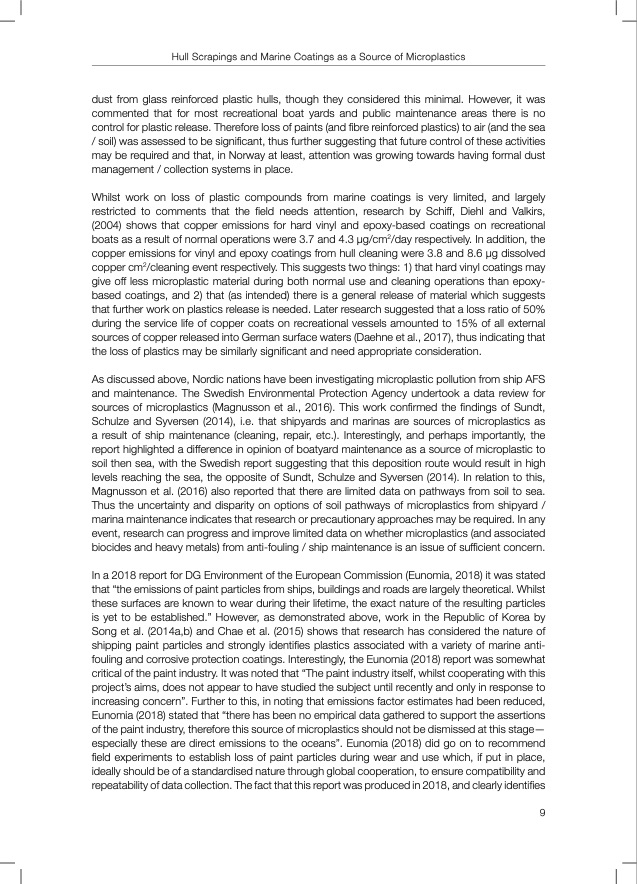
PDF Publication Title:
Text from PDF Page: 018
Hull Scrapings and Marine Coatings as a Source of Microplastics dust from glass reinforced plastic hulls, though they considered this minimal. However, it was commented that for most recreational boat yards and public maintenance areas there is no control for plastic release. Therefore loss of paints (and fibre reinforced plastics) to air (and the sea / soil) was assessed to be significant, thus further suggesting that future control of these activities may be required and that, in Norway at least, attention was growing towards having formal dust management / collection systems in place. Whilst work on loss of plastic compounds from marine coatings is very limited, and largely restricted to comments that the field needs attention, research by Schiff, Diehl and Valkirs, (2004) shows that copper emissions for hard vinyl and epoxy-based coatings on recreational boats as a result of normal operations were 3.7 and 4.3 μg/cm2/day respectively. In addition, the copper emissions for vinyl and epoxy coatings from hull cleaning were 3.8 and 8.6 μg dissolved copper cm2/cleaning event respectively. This suggests two things: 1) that hard vinyl coatings may give off less microplastic material during both normal use and cleaning operations than epoxy- based coatings, and 2) that (as intended) there is a general release of material which suggests that further work on plastics release is needed. Later research suggested that a loss ratio of 50% during the service life of copper coats on recreational vessels amounted to 15% of all external sources of copper released into German surface waters (Daehne et al., 2017), thus indicating that the loss of plastics may be similarly significant and need appropriate consideration. As discussed above, Nordic nations have been investigating microplastic pollution from ship AFS and maintenance. The Swedish Environmental Protection Agency undertook a data review for sources of microplastics (Magnusson et al., 2016). This work confirmed the findings of Sundt, Schulze and Syversen (2014), i.e. that shipyards and marinas are sources of microplastics as a result of ship maintenance (cleaning, repair, etc.). Interestingly, and perhaps importantly, the report highlighted a difference in opinion of boatyard maintenance as a source of microplastic to soil then sea, with the Swedish report suggesting that this deposition route would result in high levels reaching the sea, the opposite of Sundt, Schulze and Syversen (2014). In relation to this, Magnusson et al. (2016) also reported that there are limited data on pathways from soil to sea. Thus the uncertainty and disparity on options of soil pathways of microplastics from shipyard / marina maintenance indicates that research or precautionary approaches may be required. In any event, research can progress and improve limited data on whether microplastics (and associated biocides and heavy metals) from anti-fouling / ship maintenance is an issue of sufficient concern. In a 2018 report for DG Environment of the European Commission (Eunomia, 2018) it was stated that “the emissions of paint particles from ships, buildings and roads are largely theoretical. Whilst these surfaces are known to wear during their lifetime, the exact nature of the resulting particles is yet to be established.” However, as demonstrated above, work in the Republic of Korea by Song et al. (2014a,b) and Chae et al. (2015) shows that research has considered the nature of shipping paint particles and strongly identifies plastics associated with a variety of marine anti- fouling and corrosive protection coatings. Interestingly, the Eunomia (2018) report was somewhat critical of the paint industry. It was noted that “The paint industry itself, whilst cooperating with this project’s aims, does not appear to have studied the subject until recently and only in response to increasing concern”. Further to this, in noting that emissions factor estimates had been reduced, Eunomia (2018) stated that “there has been no empirical data gathered to support the assertions of the paint industry, therefore this source of microplastics should not be dismissed at this stage— especially these are direct emissions to the oceans”. Eunomia (2018) did go on to recommend field experiments to establish loss of paint particles during wear and use which, if put in place, ideally should be of a standardised nature through global cooperation, to ensure compatibility and repeatability of data collection. The fact that this report was produced in 2018, and clearly identifies 9PDF Image | HULL SCRAPINGS AND MARINE COATINGS AS A SOURCE OF MICROPLASTICS

PDF Search Title:
HULL SCRAPINGS AND MARINE COATINGS AS A SOURCE OF MICROPLASTICSOriginal File Name Searched:
Hull-Scrapings-report.pdfDIY PDF Search: Google It | Yahoo | Bing
Development of a solar powered Electric Ship The Electricship website originally started off as a project to develop a comprehensive renewable, affordable, modular electric ship... More Info
Modular Boat Hull Composite The case for a unsinkable, modular composite hybrid boat hull... More Info
MS Burgenstock Hybrid Electric Catamaran Lake Lucerne Unique shuttle servicing Lucerne to the Burgenstock Resort... More Info
Ground Power Unit GPU Powered by Lithium Ion Batteries The goal of the Ground Power Unit is to provide a readily accessible, modular, ready-to-power solution for remote power... More Info
| CONTACT TEL: 608-238-6001 Email: greg@electricship.com | RSS | AMP |